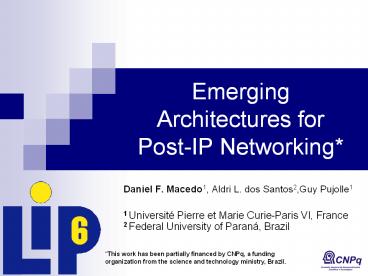Emerging Architectures for Post-IP Networking* - PowerPoint PPT Presentation
1 / 16
Title:
Emerging Architectures for Post-IP Networking*
Description:
Emerging Architectures for Post-IP Networking* Daniel F. Macedo1, Aldri L. dos Santos2,Guy Pujolle1 1 Universit Pierre et Marie Curie-Paris VI, France – PowerPoint PPT presentation
Number of Views:116
Avg rating:3.0/5.0
Title: Emerging Architectures for Post-IP Networking*
1
Emerging Architectures for Post-IP Networking
- Daniel F. Macedo1, Aldri L. dos Santos2,Guy
Pujolle1 - 1 Université Pierre et Marie Curie-Paris VI,
France - 2 Federal University of Paraná, Brazil
This work has been partially financed by CNPq, a
funding organization from the science and
technology ministry, Brazil.
2
Outline
- Why should we replace IP?
- Post-IP Architectures
- Research Challenges and Directions in Post-IP
3
The Internet Nowadays
- IP was very well-designed, being used for more
than 30 years now - IP is a victim of its own success new scenarios
with significant challenges - Node mobility
- The Internet of things small, restricted devices
4
Why should we replace IP networks?
- IP is used for identification and routing
- It changes when stations roam from one network to
another to allow proper routing - Packets addressed to the ancient IP of a station
are routed to the old network, breaking
connections
Need to decouple routing and addressing!
5
Why should we replace IP networks?
- The End-to-End (E2E) principle is frequently
violated - Smart middle-boxes, e.g. NAT and proxies that
break other E2E applications - Proxies do not work with SSL connections
- NATs are not compatible with P2P
- Context-aware networks
6
Why should we replace IP networks?
- Too difficult to be managed by humans
- Too many nodes
- Changes are frequent due to mobility
- Shift from operator-based management to
autonomic-based management - Scalable self-organizing solutions, where local
decisions lead to near optimal global behavior
7
An Overview of Post-IP Architectures
8
AdaptNet
- Goals
- Support mobile users roaming among BSs
- Deliver multimedia content over wireless links
- IP-compatible
- Solution heavy use of cross-layering
- Proactively opens TCP connections before handover
to allow seamless operation - Automatically changes the codec in the app. Layer
9
Ambient Networks, Plutarch
- Post-IP networks will be a concatenation of
autonomic heterogeneous networks - Architecture
- An autonomic management plane
- Ambient Control Space (Ambient Networks)
- Interstitial Functions (Plutarch)
- Several layers of names to cope with mobility
- Bearers, End Points and Sessions (Ambient
Networks) - Contexts (Plutarch)
10
Ambient Networks
11
NewArch
- Goals
- Redesign the Internet from scratch
- Rethink the layering model
- Provide solutions adapted to wireless links
12
NewArch
- The RBA architecture
- Role-based forwarding
- Improvement of active networks, where roles
define the code to be executed in routers - Resembles the stratum paradigm
- Addressing mobility
- Three levels of naming, allowing node and agent
mobility
13
Challenges and Directions
14
Challenges and Directions
- An urgent need to rethink layering
- IP is hard to kill Post-IP must support old
equipment - Autonomic management of post-IP networks
- No attention has been given to
- Emergent networks (ad hoc, WSNs, home networks)
- QoS
- Security
15
Challenges and Directions
- Security and Dependability
- Standards (benchmarks, tools, etc) to validate
the dependability and security of networks - Large scale test-beds
- Fast, low-cost testing of new protocols of
planetary-scale networks - Several initiatives PlanetLab, VINI, GENI
- Virtualization
16
Questions?
- Daniel.Macedo_at_rp.lip6.fr
17
Conclusions
- IP is dead long live IP!
- IP is outdated, and hinders the development of
new networks - Possible future hot topics on Post-IP
- Autonomic, mobile, QoS-aware architectures for
highly heterogeneous networks - Security and dependability
18
R3 Rewind, Repair, Replay
Failure!
Operational Status
R3 Monitor
Service
Output
Transaction
System Image
Transaction Log
19
R3 Rewind, Repair, Replay
R3 Monitor
Service
Rewind to a known consistent state
System Image
Transaction Log
20
R3 Rewind, Repair, Replay
R3 Monitor
Service
Replay old transactions
System Image
Transaction Log
21
The Triangulation Problem
We should decouple routing and addressing!
22
Research Challenges and Directions
- Network Virtualization
- Hardware becomes a substrate for different
networking protocols - Simpler roll-out of new standards through
compartmentalized networks
23
Plutarch
- Goals
- Address the pluralism of todays networks
- Solution
- A simple set of interfaces to interconnect very
different networks - Gateways interconnecting different contexts,
using interstitial functions to translate from
one paradigm to another
24
Plutarch































